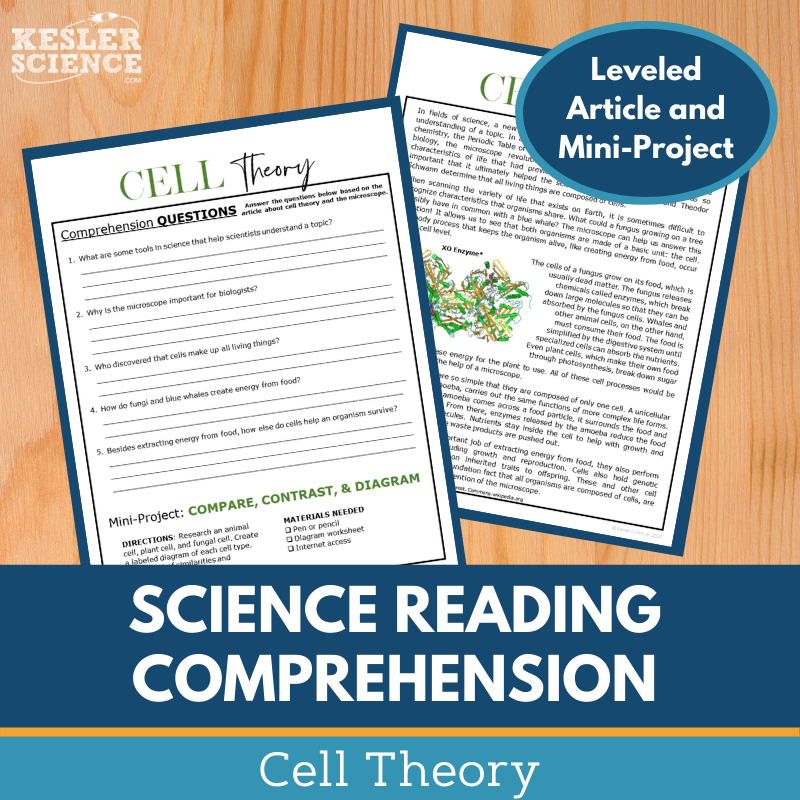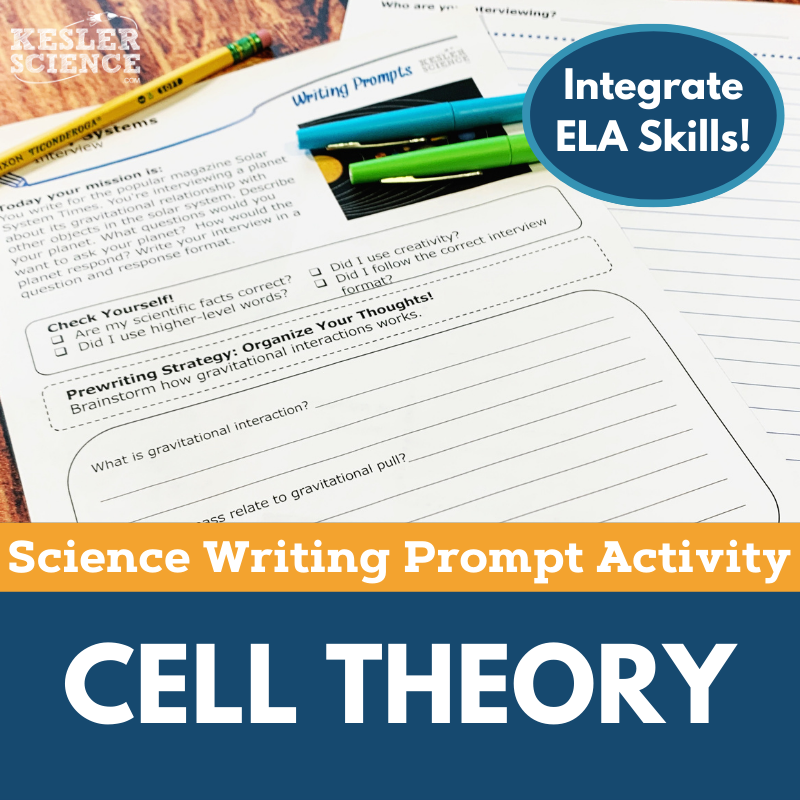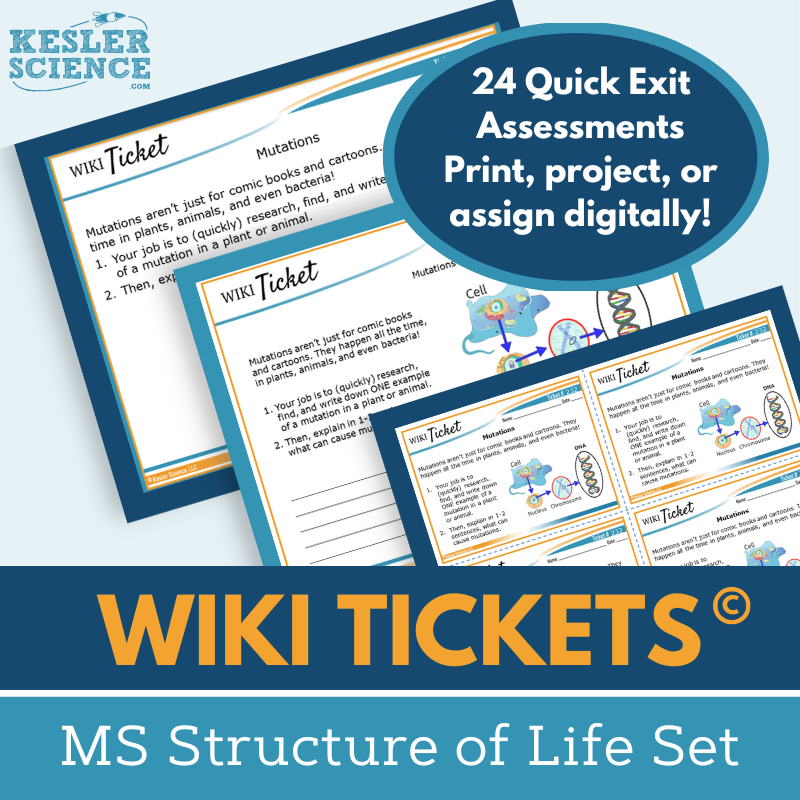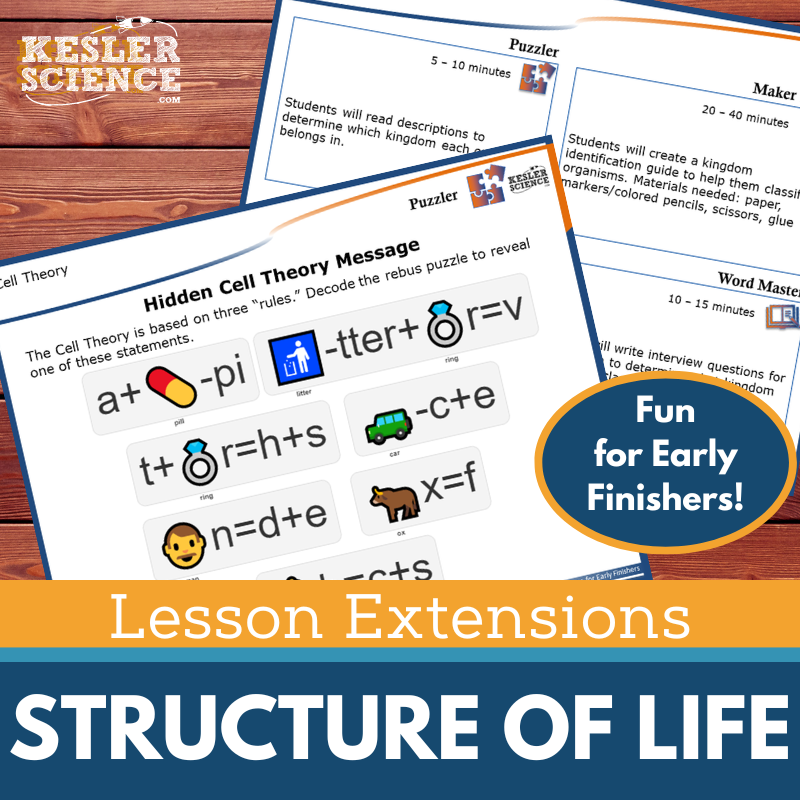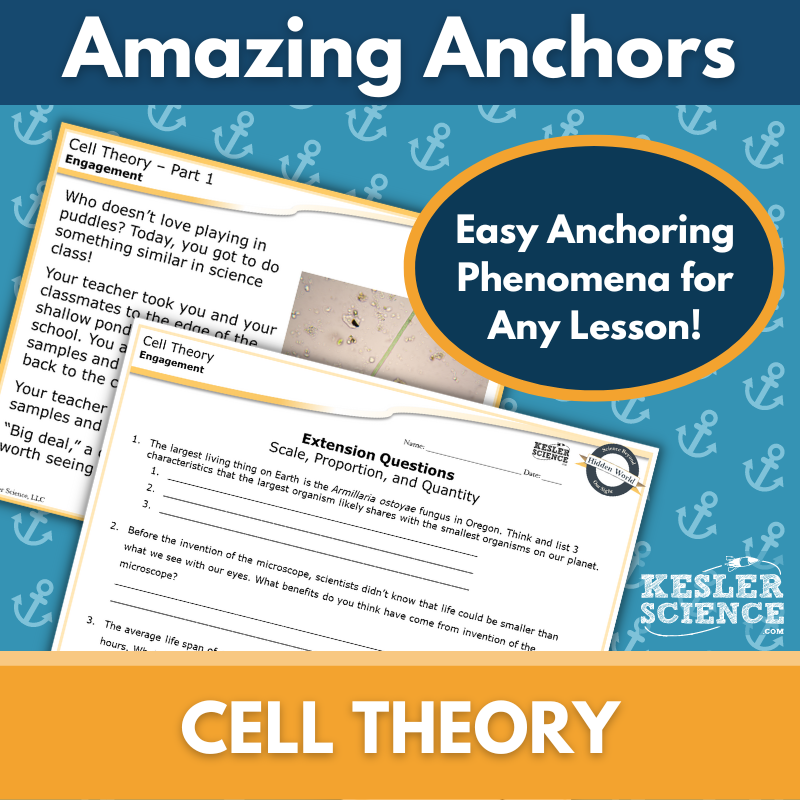Development of Cell Theory Activities for Middle School Science
The Kesler Science Cell Theory 5E Lesson is a comprehensive, low-prep life science unit designed for middle school students, aligned with the 2021 TEKS 6.13A standard. The resources below will give students a comprehensive understanding of cell theory. All of the following materials are also included in the Kesler Science Membership.
The Kesler Science Cell Theory 5E Lesson offers a comprehensive, low-prep life science unit for middle school, focused on the historical development of cell theory and the concept that all organisms are made of cells, which come from pre-existing cells and serve as the basic unit of structure and function. This differentiated, student-led lesson includes editable PowerPoints, worksheets, choice projects, assessments, and materials in English and Spanish, all aligned with the 2021 TEKS 6.13A standard.
Following the 5E Model, the lesson begins with engaging activities and vocabulary supports. Students explore cell theory through a station lab featuring nine interactive stations, including reading passages, videos, experiments, and creative tasks like drawing and organizing information. Extension activities challenge advanced learners. Explanation resources include editable presentations and interactive notebook templates in multiple formats. Students demonstrate understanding through choice projects and assessments aligned with STAAR 2.0 standards. Flexible for both in-class and virtual learning, this unit ensures all learners stay engaged while fostering a deep understanding of cell theory.
The Kesler Science Cell Theory 5E Lesson offers a comprehensive, low-prep life science unit for middle school, focused on the historical development of cell theory and the concept that all organisms are made of cells, which come from pre-existing cells and serve as the basic unit of structure and function. This differentiated, student-led lesson includes editable PowerPoints, worksheets, choice projects, assessments, and materials in English and Spanish, all aligned with the 2021 TEKS 6.13A standard.
Following the 5E Model, the lesson begins with engaging activities and vocabulary supports. Students explore cell theory through a station lab featuring nine interactive stations, including reading passages, videos, experiments, and creative tasks like drawing and organizing information. Extension activities challenge advanced learners. Explanation resources include editable presentations and interactive notebook templates in multiple formats. Students demonstrate understanding through choice projects and assessments aligned with STAAR 2.0 standards. Flexible for both in-class and virtual learning, this unit ensures all learners stay engaged while fostering a deep understanding of cell theory.
Engage your middle school students with this student-led station lab aligned with the 2021 TEKS standard 6.13A. This life science activity guides students through the historical development of cell theory, helping them understand that organisms are composed of one or more cells, which arise from pre-existing cells and serve as the basic unit of structure and function. Ideal for in-class or virtual learning, this resource offers a student-centered approach where teachers facilitate rather than direct learning.
The lab features nine interactive stations designed for independent or small-group work, complete with signage, literature, resources, and task cards. Some stations may require simple materials commonly found in most classrooms. Activities include hands-on exploration, video viewing, reading comprehension with English and Spanish passages, and research tasks. Students demonstrate their understanding by organizing information, illustrating concepts, writing responses, and completing assessments. A bonus challenge station offers extension activities like crosswords, games, and mini-projects for advanced learners. This engaging, low-prep resource encourages active participation and critical thinking.
Engage your middle school students with this student-led station lab aligned with the 2021 TEKS standard 6.13A. This life science activity guides students through the historical development of cell theory, helping them understand that organisms are composed of one or more cells, which arise from pre-existing cells and serve as the basic unit of structure and function. Ideal for in-class or virtual learning, this resource offers a student-centered approach where teachers facilitate rather than direct learning.
The lab features nine interactive stations designed for independent or small-group work, complete with signage, literature, resources, and task cards. Some stations may require simple materials commonly found in most classrooms. Activities include hands-on exploration, video viewing, reading comprehension with English and Spanish passages, and research tasks. Students demonstrate their understanding by organizing information, illustrating concepts, writing responses, and completing assessments. A bonus challenge station offers extension activities like crosswords, games, and mini-projects for advanced learners. This engaging, low-prep resource encourages active participation and critical thinking.
Engage your students with these Development of Cell Theory Student Choice Projects, aligned with the 2021 TEKS standard 6.13A. Designed for middle school learners, this resource offers six project options plus a “design your own” choice, allowing students to showcase their understanding in creative, personalized ways. A flexible grading rubric supports teacher, peer, or self-assessment and can be customized to fit specific classroom needs.
This resource includes a project choice board, teacher directions for guidance, and editable rubrics that assess vocabulary, concepts, presentation, clarity, and accuracy. Two versions of the project page provide differentiated options for remediation or enrichment, enabling teachers to assign multiple projects for an added challenge.
The projects require standard classroom supplies like paper, markers, and scissors, with many tasks adaptable for digital completion.
Engage your students with these Development of Cell Theory Student Choice Projects, aligned with the 2021 TEKS standard 6.13A. Designed for middle school learners, this resource offers six project options plus a “design your own” choice, allowing students to showcase their understanding in creative, personalized ways. A flexible grading rubric supports teacher, peer, or self-assessment and can be customized to fit specific classroom needs.
This resource includes a project choice board, teacher directions for guidance, and editable rubrics that assess vocabulary, concepts, presentation, clarity, and accuracy. Two versions of the project page provide differentiated options for remediation or enrichment, enabling teachers to assign multiple projects for an added challenge.
The projects require standard classroom supplies like paper, markers, and scissors, with many tasks adaptable for digital completion.
This Cell Theory Science Reading Comprehension Lesson helps students explore the components of cell theory through a nonfiction article, comprehension questions, and activities that compare, contrast, and diagram three types of cells. Designed for grades 6–8 (and advanced 5th graders), this leveled passage supports science literacy and reading comprehension.
The resource includes two articles with Lexile levels between 1100–1300, five to seven comprehension questions, a hands-on mini-project, and a Cornell notes template. Engaging graphics are included and can be printed in grayscale.
Ideal for virtual or in-person learning, this resource is compatible with platforms like Google Classroom, MS Teams, Schoology, and Canvas, allowing students to respond directly in the document. It’s perfect for absent students, ISS, extra credit, sub plans, or whole-class instruction. This lesson fosters critical thinking, classroom discussions, and textual analysis while reinforcing key cell theory concepts.
This Cell Theory Science Reading Comprehension Lesson helps students explore the components of cell theory through a nonfiction article, comprehension questions, and activities that compare, contrast, and diagram three types of cells. Designed for grades 6–8 (and advanced 5th graders), this leveled passage supports science literacy and reading comprehension.
The resource includes two articles with Lexile levels between 1100–1300, five to seven comprehension questions, a hands-on mini-project, and a Cornell notes template. Engaging graphics are included and can be printed in grayscale.
Ideal for virtual or in-person learning, this resource is compatible with platforms like Google Classroom, MS Teams, Schoology, and Canvas, allowing students to respond directly in the document. It’s perfect for absent students, ISS, extra credit, sub plans, or whole-class instruction. This lesson fosters critical thinking, classroom discussions, and textual analysis while reinforcing key cell theory concepts.
The Cell Theory Science Writing Prompt Activity engages middle school students in a creative, poetry-based exercise to reinforce their understanding of life science. Aligned with TEKS, this activity helps students recognize that all organisms are composed of cells, which perform essential functions such as extracting energy from food to sustain life. Designed for both in-person and virtual learning, it encourages science reasoning and writing exploration.
This low-prep, student-centered resource includes teacher directions with an answer guide, project ideas, and rubrics. It offers a projection version for classroom display, full-sized and half-sheet handouts for interactive notebooks, and a digital PowerPoint version compatible with Google Slides for remote learning.
Ideal for cross-curricular activities, pre-test assessments, student choice projects, early finisher enrichment, extra credit, make-up work, TELPAS samples, or differentiation exercises, this prompt also works well for classroom displays or student anthologies. The activity assumes prior knowledge of the topic or access to research materials.
The Cell Theory Science Writing Prompt Activity engages middle school students in a creative, poetry-based exercise to reinforce their understanding of life science. Aligned with TEKS, this activity helps students recognize that all organisms are composed of cells, which perform essential functions such as extracting energy from food to sustain life. Designed for both in-person and virtual learning, it encourages science reasoning and writing exploration.
This low-prep, student-centered resource includes teacher directions with an answer guide, project ideas, and rubrics. It offers a projection version for classroom display, full-sized and half-sheet handouts for interactive notebooks, and a digital PowerPoint version compatible with Google Slides for remote learning.
Ideal for cross-curricular activities, pre-test assessments, student choice projects, early finisher enrichment, extra credit, make-up work, TELPAS samples, or differentiation exercises, this prompt also works well for classroom displays or student anthologies. The activity assumes prior knowledge of the topic or access to research materials.
The Structure of Life WIKI Tickets© formative assessments provide an engaging way to check student understanding in 6th-8th grade science. This set includes 24 assessments, each available in five formats: a full-screen projection version, three printable handout sizes (full, split, and quarter-page), and an interactive digital version compatible with PowerPoint and Google Slides. Aligned with NGSS and TEKS standards, every topic has at least one corresponding assessment, with some standards covered by multiple tickets. A helpful table of contents is also included to show standard alignment.
These assessments cover essential life science concepts such as asexual and sexual reproduction, cell function and theory, animal and plant cells, heredity, genetic mutations, CRISPR, food chemistry, and homeostasis. Designed for flexibility, WIKI Tickets© can be used as exit tickets, bellringers, or quick checks in both in-person and virtual learning environments. Whether projecting for class discussions, distributing printed handouts, or assigning digital copies for remote learning, these assessments help gauge student understanding effectively at any point in the lesson.
The Structure of Life WIKI Tickets© formative assessments provide an engaging way to check student understanding in 6th-8th grade science. This set includes 24 assessments, each available in five formats: a full-screen projection version, three printable handout sizes (full, split, and quarter-page), and an interactive digital version compatible with PowerPoint and Google Slides. Aligned with NGSS and TEKS standards, every topic has at least one corresponding assessment, with some standards covered by multiple tickets. A helpful table of contents is also included to show standard alignment.
These assessments cover essential life science concepts such as asexual and sexual reproduction, cell function and theory, animal and plant cells, heredity, genetic mutations, CRISPR, food chemistry, and homeostasis. Designed for flexibility, WIKI Tickets© can be used as exit tickets, bellringers, or quick checks in both in-person and virtual learning environments. Whether projecting for class discussions, distributing printed handouts, or assigning digital copies for remote learning, these assessments help gauge student understanding effectively at any point in the lesson.
Lesson Extensions offer engaging, student-choice activities designed to challenge early finishers and deepen their understanding of life science concepts aligned with NGSS and TEKS standards. These activities help reinforce critical thinking, creativity, and problem-solving while keeping students engaged during downtime, lesson wrap-ups, or testing periods.
Each extension features four interactive components: Puzzler for problem-solving challenges, Maker Space for hands-on STEAM activities, Tech Connection for digital learning demonstrations, and Word Master for creative writing tasks. Resources include teacher directions, answer keys, and both digital projection and printable versions for flexible classroom use.
Covering topics such as artificial selection, body systems, cell functions, organelles, dichotomous keys, genetic mutations, heredity, kingdoms, natural selection, and reproductive success, these extensions offer rigorous, independent learning opportunities that encourage students to dive deeper into life science concepts.
Lesson Extensions offer engaging, student-choice activities designed to challenge early finishers and deepen their understanding of life science concepts aligned with NGSS and TEKS standards. These activities help reinforce critical thinking, creativity, and problem-solving while keeping students engaged during downtime, lesson wrap-ups, or testing periods.
Each extension features four interactive components: Puzzler for problem-solving challenges, Maker Space for hands-on STEAM activities, Tech Connection for digital learning demonstrations, and Word Master for creative writing tasks. Resources include teacher directions, answer keys, and both digital projection and printable versions for flexible classroom use.
Covering topics such as artificial selection, body systems, cell functions, organelles, dichotomous keys, genetic mutations, heredity, kingdoms, natural selection, and reproductive success, these extensions offer rigorous, independent learning opportunities that encourage students to dive deeper into life science concepts.
This Amazing Anchors Phenomenon Lesson introduces and reinforces cell theory concepts through real-world connections with microscopic pond organisms. It begins with an introductory reading accompanied by comprehension and extension questions to build foundational knowledge. An explanatory reading then breaks down the science behind cell theory in an accessible way, with additional questions to deepen understanding.
TEKS aligned, this no-prep resource includes teacher directions, answer keys, projection slides, and both print and digital formats for use on platforms like Google Classroom. A differentiated version offers language support and sentence starters to assist students. Designed to bookend any lesson, this engaging resource is ideal for introducing or revisiting cell theory concepts.
This Amazing Anchors Phenomenon Lesson introduces and reinforces cell theory concepts through real-world connections with microscopic pond organisms. It begins with an introductory reading accompanied by comprehension and extension questions to build foundational knowledge. An explanatory reading then breaks down the science behind cell theory in an accessible way, with additional questions to deepen understanding.
TEKS aligned, this no-prep resource includes teacher directions, answer keys, projection slides, and both print and digital formats for use on platforms like Google Classroom. A differentiated version offers language support and sentence starters to assist students. Designed to bookend any lesson, this engaging resource is ideal for introducing or revisiting cell theory concepts.
Year-Round Resources
These year-round activities will increase your students' understanding of many middle school science topics. All of these activities are also included in the Kesler Science Membership.
Visual Data & Graphing
You're not alone if your students struggle with understanding graphs, charts, and tables. It's a skill that takes an enormous amount of practice. This resource will help students build a strong foundation in analyzing data and creating their own data visualizations.
Bell Ringers and Warm-Ups
These middle school science bell ringers are an excellent way to engage your students as soon as they walk into your classroom. This comprehensive FULL YEAR resource includes everything you need to start off each science class with an interesting warm-up activity.
Review Board Games
Each game board has been carefully designed to keep students engaged. There are 10 different action spaces on each board and dozens of question cards. All of the actions are related to science concepts and keep the students motivated throughout the game.
Each game is ready to play. Simply print out the board and the cards and let the students enjoy reviewing nine different units.
Essential Questions and Standards
Below are the essential questions and standards associated with the lessons and activities included in the atoms unit. This topic is only one of more than 100 middle school science topics included in the Kesler Science Membership.
-
Can you describe the historical development of cell theory?
-
How does cell theory explain that organisms are composed of one or more cells, which come from pre-existing cells, and are the basic unit of structure and function?
-
TEKS Science - 6.13A Development of Cell Theory
Kesler Science Membership
Imagine never having to search for another middle school science lesson again. The membership gives you access to ALL of the Kesler Science products in one place (Yes, including everything above).
Say goodbye to long hours of lesson prep.







